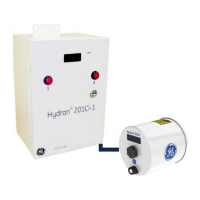12.1 Operating Methods
The Hydran 201 i System can be operated using several methods. Each of these
methods is explained in the following pages, from the simplest to the most powerful one:
• Periodic, visual monitoring: See Section 12.1.1below.
• Alarm monitoring: See Section 12.1.2.
• Analog output monitoring: See Section 12.1.3.
• Combined alarm and analog output monitoring: See Section 12.1.4.
• Local monitoring with host computer: See Section 12.1.5.
• Remote monitoring with host computer: See Section 12.1.6.
12.1.1 Periodic, Visual Monitoring
Among the Hydran 201i System’s operating methods, the periodic, visual monitoring
is the simplest. If used, the following routine must be an integral part of the on-site,
station inspection:
• Periodic, visual reading (once or twice a day) of the gas level reading on the
display of the Hydran 201Ti’s or the Hydran 201Ci-1. For details on the various
methods of data reading, see Section 12.2.
• On-site verification of alarms. For details on the alarms and relays operation,
see Chapter 11.
• Manual logging of the above results.
Only basic training to the station’s personnel is required to implant this operating
method. When an alarm is detected, the operator must report the alarm and take the
appropriate actions for this type of alarm (follow the regulations and practices of the
company).
Note: With this method, the analog outputs and the alarm contacts are not connected to
a SCADA system.
1.1.1.12 Method Drawbacks
The periodic, visual monitoring method has a deficient response time following the
detection of an alarm; this response time cannot be inferior to the period of time
between two inspections. The Hydran 201i System, however, has a response time
measured in minutes.

